Key Information Documents (KID)
IBKR is required to provide EEA and UK retail customers with Key Information Documents (KID) for certain financial instruments.
Relevant products include ETFs, Futures, Options, Warrants, Structured Products, CFDs and other OTC products. Funds include both UCITS and non-UCITS funds available to retail investors.
Generally KIDs must be provided in an official language of the country in which a client is resident.
However, clients of IBKR have agreed to receive communications in English, and therefore if a KID is available in English all EEA and UK clients can trade the product regardless of their country of residence.
In cases where a KID is not available in English, IBKR additionally supports other languages as follows:
| Language | Can be traded by residents or citizens* of |
| German | Germany, Austria, Belgium, Luxembourg and Liechtenstein |
| French | France, Belgium and Luxembourg |
| Dutch | the Netherlands and Belgium |
| Italian | Italy |
| Spanish | Spain |
*regardless of country of residence
IBKR(UK)におけるESMAルール導入の概要 - 個人投資家のみ対象
|
CFDはレバレッジによる損失のリスクが高い複雑な商品です。
63.7%の個人投資家口座に、IBKRとのCFD取引による損失が発生しています。
お取引を開始される前にCFDの機能、また損失の際のリスクをご理解ください。 |
欧州証券市場監督局(ESMA)は、CFDを取引する個人投資家に対し、2018年8月1日より適用となるルールを実施しました。特定投資家のお客様への影響はありません。
ルールの構成は以下のようになります: 1) レバレッジの上限、 2) 口座単位のマージン・クローズアウト、 3) 口座単位のマイナス残高の保護、 4) CFD取引に対するインセンティブの制限、 5) リスク警告の標準化。
ほとんどのお客様は(規制対象となる事業体以外)まず個人投資家に分類されます。IBKRでは、場合によっては個人投資家のお客様を特定投資家に、または特定投資家のお客様を個人投資家に再分類することがあります。詳細は、MiFID分類基準をご覧ください。
下記の項目では、IBKR(UK)におけるESMAルールの導入に関してご説明しています。
1 レバレッジの上限
1.1 ESMA証拠金
レバレッジの上限は、原資産によって違うレベルにESMAが設定しています:
- 主要な通貨ペアには3.33%。USD、CAD、EUR、GBP、CHF、JPYの組み合わせは、すべて主要な通貨ペアとなります。
- 主要ではない通貨ペアおよび主要な指数には5%。
- 主要ではない通貨ペアはUSD.CNHなどの、上に記載されない通貨を組み合わせたペアとなります。
- 主要な指数は、IBUS500、IBUS30、IBUST100、IBGB100、IBDE40、IBEU50、IBFR40、IBJP225、IBAU200になります。
- 主要ではない株式指数には10%。IBES35、IBCH20、IBNL25、IBHK50
- 個別株式には20%。
1.2適用となる証拠金 - 標準要件
IBKR(UK)ではESMA証拠金に加え、原資産の過去の変動やその他の要因に基づいて、自社の証拠金(IB証拠金)を設定しています。 IB証拠金はESMAの設定によるものを上回る場合に適用されます。
適用となるIBおよびESMAの証拠金に関する詳細は、こちらよりご確認下さい。
1.2.1適用となる証拠金 - 最低コンセントレーション
ポートフォリオが少量のCFDからなる場合、または最も大きいポジションふたつのウェイトが優勢な場合には、コンセントレーション・チャージが適用されます。弊社では、最も大きなポジションふたつには30%の不利な動き、残りのポジションに5%の不利な動きを適用してストレステストにかけます。損失の合計が標準証拠金を上回った場合には、これが維持証拠金として適用されます。
1.3委託証拠金として利用可能な資金
CFDのポジションを建てる場合の委託証拠金は、現金のみご利用可能です。CFDの実現利益は現金に含まれすぐに利用可能になります。現金が先に決済される必要はありません。未実現利益の場合は異なり、委託証拠金として利用することはできません。
1.4委託証拠金の自動資金調達(Fセグメント)
IBKR(UK)では、CFD用の委託証拠金の供給として、お客様のメイン口座から口座内のFセグメントに資金を自動的に移動します。
CFDの維持証拠金のために資金が移動されることはありませんのでご注意ください。このため、メイン口座に十分なご資金があっても、適格株式(以下に定義)が必要証拠金を満たすことができなくなる場合には強制決済されます。強制決済を避けるにはアカウント・マネジメントより、Fセグメントに追加の資金を入れて下さい。
2 マージン・クローズアウトに関するルール
2.1維持証拠金の計算と清算
対象となる資本がポジションを建てるために利用された委託証拠金の50%を下回った場合、IBKRではESMAの規制により、CFDのポジションを最後に清算するよう義務付けられています。IBKRでは、弊社のリスクに対する見解がより保守的な場合には早めにポジションを決済することがあります。 対象となる資本には、Fセグメント内の現金(口座の他のセグメントの現金は含まず)および未実現のCFD損益(プラスおよびマイナス)が含まれます。
この計算は、CFDのポジションを建てる時点での委託証拠金に基づいて行われます。 CFD以外のポジションに適用される証拠金計算とは異なり、オープンポジションの価値が変わっても委託証拠金の金額は変わりません。
2.1.1取引例
お客様はCFD口座にEUR 2000お持ちです。XYZのCFDを100枚、EUR 100の指値価格で購入を希望されています。CFDの初めの50枚が約定し、そのあと残りの50枚が約定します。ご利用可能な現金額が取引の約定と共に減っていきます:
| 現金 | 資本* | ポジション | 価格 | 価値 | 未実現損益 | IM | MM | 利用可能な現金 | MM違反 | |
| 取引前 | 2000 | 2000 | 2000 | |||||||
| 取引後 1 | 2000 | 2000 | 50 | 100 | 5000 | 0 | 1000 | 500 | 1000 | 不可 |
| 取引後 2 | 2000 | 2000 | 100 | 100 | 10000 | 0 | 2000 | 1000 | 0 | 不可 |
*資本は現金と評価損益の合計と同等です。
価格が110に上がります。現在の資本は3000ですが、利用可能な現金がまだ0のため新しいポジションを追加で建てることはできません。また、ESMAの規制により、IMおよびMMには変化はありません:
| 現金 | 資本 | ポジション | 価格 | 価値 | 未実現損益 | IM | MM | 利用可能な現金 | MM違反n | |
| 変化 | 2000 | 3000 | 100 | 110 | 11000 | 1000 | 2000 | 1000 | 0 | 不可 |
価格がこのあと95に下がります。資本は1500に減りますが、必要となる1000以上なため、証拠金不足にはなりません:
| 現金 | 資本 | ポジション | 価格 | 価値 | 未実現損益 | IM | MM | 利用可能な現金 | MM違反 | |
| 変化 | 2000 | 1500 | 100 | 95 | 9500 | (500) | 2000 | 1000 | 0 | 不可 |
価格がさらに85に下がり、証拠金不足が発生するため清算となります:
| 現金 | 資本 | ポジション | 価格 | 価値 | 未実現損益 | IM | MM | 利用可能な現金 | MM違反 | |
| 変化 | 2000 | 500 | 100 | 85 | 8500 | (1500) | 2000 | 1000 | 0 | 可能 |
3 ネガティブ・エクイティ・プロテクション
ESMAの規制により、CFDに関連するお客様のご責任はCFD取引専用の資金に限定されます。株式や先物などその他の銘柄は、CFDの証拠金不足を解消するために清算することはできません。*
このため、メイン口座の有価証券およびコモディティセグメントに含まれる資産、またFセグメント内のCFDとは関連のない資産は、CFD取引に伴うキャピタル・アット・リスクには含まれませんが、Fセグメント内の現金はすべて、CFD取引から生じる損失のカバーに利用することができます。
ネガティブ・エクイティ・プロテクションはIBKRにとって追加的なリスクとなるため、個人投資家のお客様にはオーバーナイトで保有されるCFDポジションに対し、追加で1%スプレッドをご請求させていただきます。CFD借入金利の詳細は、こちらよりご確認下さい。
*CFDの不足分の補填としてCFD以外のポジションを清算することはできませんが、CFD以外の不足分を補填するためにCFDのポジションを清算することは可能です。
4 CFD取引のためのインセンティブ
ESMAの規制により、CFD取引に関連する金銭的利益、また特定のタイプの非金銭的利益は禁止となっています。IBKRでは、CFD取引に対していかなるボーナスやその他のインセンティブも提供しておりません。
「EMIR」: 取引情報蓄積機関への報告義務およびお客様の義務達成をサポートするインタラクティブ・ブローカーズの代行サービス
IBIEおよびIBCEにおける個人投資家向けESMAルール導入の概要
|
CFDはレバレッジによる損失のリスクが高い複雑な商品です。 68.7%の個人投資家口座に、IBKRとのCFD取引による損失が発生しています。 お取引を開始される前にCFDの機能、また損失の際のリスクをご理解ください。 |
欧州証券市場監督局(ESMA)は、CFDを取引する個人投資家に対し、2018年8月1日より適用となるルールを実施しました。特定投資家のお客様への影響はありません。
国内の規制当局はESMAによるルールを永久的に採択しました。
ルールの構成は以下のようになります: 1) レバレッジの上限、 2) 口座単位のマージン・クローズアウト、 3) 口座単位のマイナス残高の保護、 4) CFD取引に対するインセンティブの制限、 5) リスク警告の標準化。
ほとんどのお客様は(規制対象となる事業体以外)まず個人投資家に分類されます。IBKRでは、場合によっては個人投資家のお客様を特定投資家に、または特定投資家のお客様を個人投資家に再分類することがあります。詳細は、MiFID分類基準をご覧ください。
下記の項目では、IBKRにおけるESMAルールの導入に関してご説明しています。
1 レバレッジの上限
1.1 ESMA証拠金
レバレッジの上限は、原資産によって違うレベルにESMAが設定しています:
- 主要な通貨ペアには3.33%。USD、CAD、EUR、GBP、CHF、JPYの組み合わせは、すべて主要な通貨ペアとなります。
- 主要ではない通貨ペアおよび主要な指数には5%。
- 主要ではない通貨ペアはUSD.CNHなどの、上に記載されない通貨を組み合わせたペアとなります。
- 主要な指数は、IBUS500、IBUS30、IBUST100、IBGB100、IBDE40、IBEU50、IBFR40、IBJP225、IBAU200になります。
- 主要ではない株式指数には10%。IBES35、IBCH20、IBNL25、IBHK50
- 個別株式には20%。
1.2適用となる証拠金 - 標準要件
IBKRではESMA証拠金に加え、原資産の過去の変動やその他の要因に基づいて、自社の証拠金(IB証拠金)を設定しています。 IB証拠金はESMAの設定によるものを上回る場合に適用されます。
適用となるIBおよびESMAの証拠金に関する詳細は、こちらよりご確認下さい。
1.2.1適用となる証拠金 - 最低コンセントレーション
ポートフォリオが少量のCFDおよび/または株式のポジションからなる場合、または最も大きいポジションふたつのウェイトが優勢な場合には、コンセントレーション・チャージが適用されます。弊社では、最も大きなポジションふたつには30%の不利な動き、残りのポジションに5%の不利な動きを適用してストレステストにかけます。損失の合計が、株式とCFDのポジションの組み合わせに必要となる標準証拠金を上回った場合には、これが維持証拠金として適用されます。CFDと株式の証拠金が組み合わされた場合のみ、コンセントレーション・チャージが発生します。
1.3委託証拠金の資金調達
CFDのポジションを建てる場合の委託証拠金は、現金のみご利用可能です。
初めに口座に入金された資金はCFD取引に利用できます。その他の銘柄の委託証拠金や株式の購入に現金を利用することにより、利用可能な現金が減っていきます。株式の購入によって証拠金の借入れが発生した場合、口座に十分な資金があってもCFD取引には利用できません。ESMAの規制により、CFDのための証拠金として証拠金の借入れを増やすことはできません。
CFDの実現利益は現金に含まれすぐに利用可能になります。現金が先に決済される必要はありません。未実現利益の場合は異なり、委託証拠金として利用することはできません。
2 マージン・クローズアウトに関するルール
2.1維持証拠金の計算と清算
対象となる資本がポジションを建てるために利用された委託証拠金の50%を下回った場合、IBKRではESMAの規制により、CFDのポジションを最後に清算するよう義務付けられています。IBKRでは、弊社のリスクに対する見解がより保守的な場合には早めにポジションを決済することがあります。 対象となる資本には、CFDの現金および未実現のCFD損益(プラスおよびマイナス)が含まれます。CFD現金にはその他の銘柄用の必要証拠金は含まれませんのでご注意下さい。
この計算は、CFDのポジションを建てる時点での委託証拠金に基づいて行われます。 CFD以外のポジションに適用される証拠金計算とは異なり、オープンポジションの価値が変わっても委託証拠金の金額は変わりません。
2.1.1取引例
口座に現金でEUR 2000があり、オープンポジションはありません。XYZのCFDを100枚、EUR 100の指値価格で購入を希望されています。CFDの初めの50枚が約定し、そのあと残りの50枚が約定します。ご利用可能な現金額が取引の約定と共に減っていきます:
|
|
現金 |
資本* |
ポジション |
価格 |
価値 |
未実現損益 |
IM |
MM |
利用可能な現金 |
MM違反 |
|
取引前 |
2000 |
2000 |
|
|
|
|
|
|
2000 |
|
|
取引後 1 |
2000 |
2000 |
50 |
100 |
5000 |
0 |
1000 |
500 |
1000 |
不可 |
|
取引後 2 |
2000 |
2000 |
100 |
100 |
10000 |
0 |
2000 |
1000 |
0 |
不可 |
*資本は現金と評価損益の合計と同等です。
価格が110に上がります。現在の資本は3000ですが、利用可能な現金がまだ0のため新しいポジションを追加で建てることはできません。また、ESMAの規制により、IMおよびMMには変化はありません:
|
|
現金 |
資本 |
ポジション |
価格 |
価値 |
未実現損益 |
IM |
MM |
利用可能な現金 |
MM違反 |
|
変化 |
2000 |
3000 |
100 |
110 |
11000 |
1000 |
2000 |
1000 |
0 |
不可 |
価格がこのあと95に下がります。資本は1500に減りますが、必要となる1000以上なため、証拠金不足にはなりません:
|
|
現金 |
資本 |
ポジション |
価格 |
価値 |
未実現損益 |
IM |
MM |
利用可能な現金 |
MM違反 |
|
変化 |
2000 |
1500 |
100 |
95 |
9500 |
(500) |
2000 |
1000 |
0 |
不可 |
価格がさらに85に下がり、証拠金不足が発生するため清算となります:
|
|
現金 |
資本 |
ポジション |
価格 |
価値 |
未実現損益 |
IM |
MM |
利用可能な現金 |
MM違反 |
|
変化 |
2000 |
500 |
100 |
85 |
8500 |
(1500) |
2000 |
1000 |
0 |
可能 |
3 ネガティブ・エクイティ・プロテクション
ESMAの規制により、CFDに関連するお客様のご責任はCFD取引専用の資金に限定されます。株式や先物などその他の銘柄は、CFDの証拠金不足を解消するために清算することはできません。*
このためCFDとは関連のない資産は、CFD取引に伴うキャピタル・アット・リスクには含まれません。
お客様がCFD取引にあてた現金以上の損害が発生した場合、弊社ではこの損失を切捨てします
ネガティブ・エクイティ・プロテクションはIBKRにとって追加的なリスクとなるため、個人投資家のお客様にはオーバーナイトで保有されるCFDポジションに対し、追加で1%スプレッドをご請求させていただきます。CFD借入金利の詳細は、こちらよりご確認下さい。
*CFDの不足分の補填としてCFD以外のポジションを清算することはできませんが、CFD以外の不足分を補填するためにCFDのポジションを清算することは可能です。
IBKRアイルランドおよび中央ヨーロッパにおけるリテールクライアント用TWS口座ウィンドウ
こちらのページでは、EUにおけるIBKR事業体のTWS口座ウィンドウに表示される情報についてご説明します。
|
CFDはレバレッジによる損失のリスクが高い複雑な商品です。 63.7%の個人投資家口座に、IBKRとのCFD取引による損失が発生しています。 お取引を開始される前に、CFDがどのように機能するものか、また損失の際のリスクをご理解ください。 |
EEAに居住し、このためヨーロッパのIBKR事業体であるIBIEまたはIBCEに口座をお持ちのリテールクライアントのお客様は、CFD取引に適用されるレバレッジおよびその他のEU規制の対象となります。
特に、CFDの必要証拠金にかかる要件を満たすためのフリーキャッシュの使用が規制によって必要となります。リテールクライアントのお客様は、CFDのポジションを建てるまたは維持するために資金を借入れする場合、口座内の有価証券を担保として使用することが禁止されています。詳細は、IBIEおよびIBCEにおけるリテールクライアントに適用となるESMA CFDルール概要をご確認下さい。
IBKRのEU事業体における口座は、弊社のプラットフォームで利用可能なすべての資産クラスを利用できるユニバーサル口座ですが、弊社の米国や英国の事業体とは異なり、個別に資金の入金ができるセグメントはありません。
この規制が適用される例および、CFD取引に利用可能なフリーキャッシュをモニターする方法は、以下のようになります。
口座ウィンドウ
CFDの委託証拠金および維持証拠金をカバーするために利用可能なフリーキャッシュが不十分な場合、弊社ではフリーキャッシュに関する制限を適用します。これは、CFD取引に利用可能な資金のリアルタイム・ベースの計算、新しい注文の拒否、既存のポジションの強制決済によって行われます。
CFD取引に利用可能なフリーキャッシュのモニター機能は、口座のフリーキャッシュ・レベルを表示するように強化された、TWSの口座ウィンドウよりご提供しています。CFD取引に利用可能な資金が別のセグメントに保有されているものかどうかは表示されません。この機能は口座の残高合計のうち、どれだけがCFD取引に利用可能かを表示します。
例として、口座にEUR 9,705の現金が保有され、ポジションはないものと仮定します。CFDのポジション、またはどの資産クラスのポジションを建てるにしても現金をすべて利用することができます:
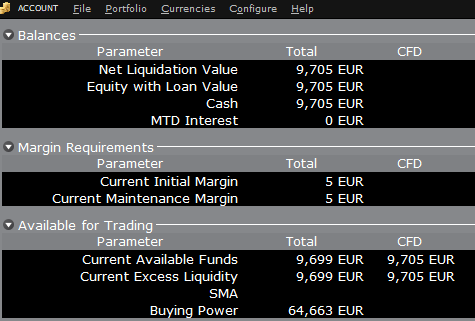
この状態でAAPLの株式を10株、合計USD 1,383分購入する場合、口座の現金はこれに相当するEURの金額分減り、
CFD取引に利用可能な資金がこれと同じ分減ります:
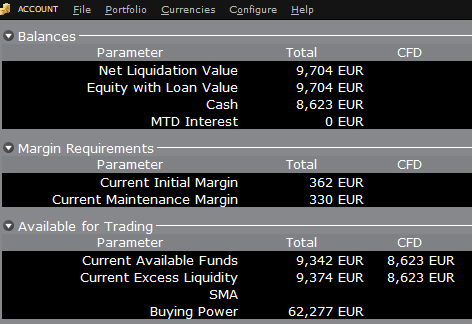
利用可能な資金の合計は株式の必要証拠金に対応する金額分減り、これは若干少ない金額になります。
AAPL株式の代わりにAAPL CFDを10株購入する場合、状況は少し異なります。原資産の購入ではなく、デリバティブ・コントラクトの取引となるために現金は減りませんが、コントラクトのパフォーマンスを保証するためCFDに利用可能な資金がCFDの必要証拠金分減ります:
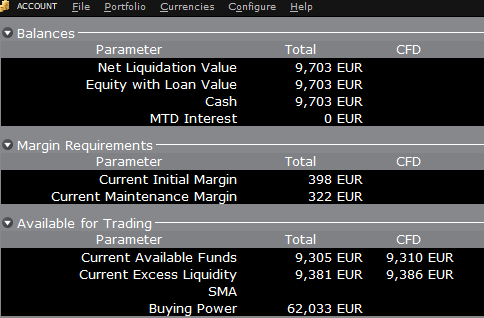
この場合の利用可能な資金の合計とCFDに利用可能な資金は、CFDの必要証拠金である同額になります。
資金
上に記載されるように、EUベースの口座には個別のセグメントがありません。このため口座間の送金は必要ではありません。資金は口座ウィンドウに表示される金額ですべての資産クラスに利用できます。移動や送金の必要はありません。
口座にマイナスの現金残高となる証拠金の借入れがある場合、CFDのポジションを建てることはできません。これはCFDの必要証拠金が、プラスの現金残高であるフリーキャッシュでないとならないためです。証拠金の借入れがある上でCFD取引をご希望の場合には、借入れをなくすべく先ず証拠金のポジションを決済するか、借入れをカバーする現金を口座に入金してCFD証拠金のためのバッファーを設けて下さい。
TWS Account Window for Retail Clients of IBKR Ireland and Central Europe
This article describes the information provided in the TWS account window for IBKRs EU based entities.
|
CFDs are complex instruments and come with a high risk of losing money rapidly due to leverage. 61% of retail investor accounts lose money when trading CFDs with IBKR. You should consider whether you understand how CFDs work and whether you can afford to take the high risk of losing your money. |
Retail clients who are residents of the EEA and therefore maintain an account with one of IBKR’s European brokers, IBIE or IBCE, are subject to EU regulations which introduce leverage and other restrictions applicable to CFD transactions.
Notably the regulations require the use of free cash to satisfy CFD margin requirements and prohibit retail clients from using securities in the account as collateral to borrow funds to initiate or maintain a CFD position. Please see Overview of ESMA CFD Rules Implementation for Retail Clients at IBIE and IBCE for full details.
The accounts of IBKRs EU entities are universal accounts in which clients can trade all asset classes available on IBKRs platform, but unlike IBKRs US and UK entities, there are no separately funded segments.
Working examples of how this restriction is applied, along with details as to how clients can monitor free cash available for CFD transactions, are outlined below.
Account Window
IBKR enforces the restriction relating to free cash by calculating the funds available for CFD trading on a real-time basis, rejecting new orders and liquidating existing positions when the available free cash is insufficient to cover CFD initial and maintenance margin requirements.
IBKR offers clients the ability to monitor free cash available for CFD transactions via an enhancement to the TWS Account Window which displays the level of free cash in the account. Importantly, the funds shown as available for CFD trading do not imply that cash is held in a separate segment. It simply indicates what proportion of total account balances is available for CFD trading.
For example, assume that an account has EUR 9,705 in cash and no positions. All the cash is available to open CFD positions, or positions in any other asset class:

If the account now purchases 10 shares of AAPL stock for an aggregate value of USD 1,383 the cash in the account is reduced by a corresponding amount in EUR, and the funds available for CFD trading are reduced by the
same amount:

Note that Total available funds are reduced by a smaller amount, corresponding to the stock margin requirement.
If, instead of buying AAPL stock, the account buys 10 AAPL CFDs the impact will be different. As the transaction involves a derivative contract rather than the purchase of the underlying asset itself, there’s no reduction in cash but the funds available for CFDs are reduced by the CFD margin requirement to secure performance on the contract:

In this case Total available funds and CFD available funds are reduced by an equal amount; the CFD margin requirement.
Funding
As noted above, EU-based accounts do not have segments and therefore there is no need for internal transfers. Funds are available for trades in all asset classes in the amounts indicated in the account window, without the need for sweeps or transfers.
Note also that should an account have a margin loan, i.e. negative cash, it will not be possible to open CFD positions since the CFD margin requirement must be satisfied by free, positive cash. Should you have a margin loan and wish to trade CFDs you must first either close margin positions to eliminate the loan, or add cash to the account in an amount that covers the margin loan and creates a cash buffer sufficient for the necessary CFD margin.
IBKR Metals CFDs – Facts and Q&A
The following article is intended to provide a general introduction to London Gold and Silver Contracts for Differences (CFDs) issued by IBKR.
Please follow these links for information on IBKR Share CFDs, Index CFDs and Forex CFDs.
Risk Warning
CFDs are complex instruments and come with a high risk of losing money rapidly due to leverage.
61% of retail investor accounts lose money when trading CFDs with IBKR.
You should consider whether you understand how CFDs work and whether you can afford to take the
high risk of losing your money.
ESMA Rules for CFDs (Retail Clients only)
The European Securities and Markets Authority (ESMA) has enacted new CFD rules effective 1st August
2018.
The rules include: 1) leverage limits on the opening of a CFD position; 2) a margin close out rule on a per
account basis; and 3) negative balance protection on a per account basis.
The ESMA Decision is only applicable to retail clients. Professional clients are unaffected.
Please refer to the following articles for more detail:
ESMA CFD Rules Implementation at IBKR (UK) and IBKR LLC
ESMA CFD Rules Implementation at IBIE and IBCE
Introduction
A London Gold CFD enables you to have exposure to price movements of physical Gold without actually owning it. A London Gold CFD is an agreement between you and IBKR to exchange the difference in price of the underlying over a period of time. The difference to be exchanged is determined by the change in the reference price of the underlying. Thus, if the price of physical Gold traded on the London bullion market rises and you are long the CFD, you receive cash from IBKR and vice versa. A London Gold CFD can be bought long or sold short to suit your view of market direction in the future.
Contract Specifications
| Contract | IBKR Symbol | Per Trade Fee | Minimum per Order | Multiplier |
| London Gold | XAUUSD | 0.015% | USD 2.00 | 1 |
| London Silver | XAGUSD | 0.03% | USD 2.00 | 1 |
Price Determination
The IBKR London Gold and Silver CFDs reference physical Gold and Silver traded on the London bullion market. The London bullion market is a wholesale over-the-counter market for the trading of precious metals. Trading is conducted among members of the London Bullion Market Association (LBMA). Most of the members are major international banks.
IBKR receives quote streams from approximately 10 such major banks, in much the same way it does for cash forex. IBKR Smart routes between the banks, and the best available price at any given time becomes the reference price for the CFDs. IBKR does not add a spread to the banks’ quotes.
Low Commissions and Financing Rates: Unlike other CFD providers IBKR charges a transparent
commission, rather than widening the spread. Commission rates are only 0.015% for London Gold and 0.03% for London Silver. Overnight financing rates are just benchmark +/- 1.5% (an additional 1% surcharge is added for retail accounts).
Transparent Quotes: Because IBKR does not widen the spread, the Metals CFD quotes accurately
represent the spreads and price movements of the related cash metal, as described above.
Margin Efficiency: IBKR establishes house-margin requirements based on historic volatility of the
underlying and other factors. Retail clients are subject to regulatory minimum initial margins of 5% for
London Gold or 10% for London Silver.
Trading Permissions: Same as for Share and Index CFDs.
Market Data Permissions: Metals CFD market data is free, but a permission is required for system
reasons.
Worked Trade Example (Professional Clients):
You purchase 100 XAUUSD CFDs at $1,942.5 for USD 194,250 which you then hold for 5 days.
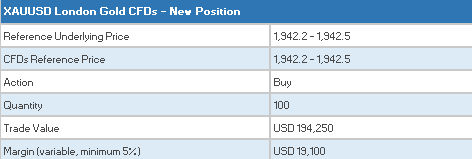
![]()
Closing the Position
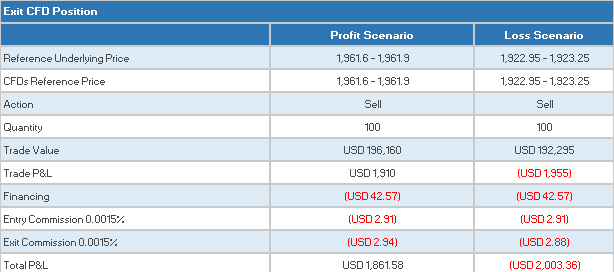
CFD Resources
Below are some useful links with more detailed information on IB’s CFD offering:
Frequently asked Questions
Are short Metals CFDs subject to forced buy-in?
No.
Can I take delivery of the underlying metal?
No, IBKR does not support physical delivery for Metals CFDs.
Are there any market data requirements?
The market data for Metal CFDs is free, and is included the market data for Index CFDs. However, you need to subscribe to the permission for system reasons. To do this, log into Account Management, and click through the following tabs: Settings/User Settings/Trading Platform/Market Data Subscriptions. Alternatively you can set up an Index or Metals CFD in your TWS quote monitor and click the “Market Data Subscription Manager” button that appears on the quote line.
How are my CFD trades and positions reflected in my statements?
If you are a client of IBKR (U.K.) or IBKR LLC, your CFD positions are held in a separate account segment identified by your primary account number with the suffix “F”. You can choose to view Activity Statements for the F-segment either separately or consolidated with your main account. You can make the choice in the statement window in Account Management.
If you are a client of other IBKR entities, there is no separate segment. You can view your positions normally alongside your non-CFD positions.
In what type of IB accounts can I trade CFDs e.g., Individual, Friends and Family,
Institutional, etc.?
All margin and cash accounts are eligible for CFD trading.
Can I trade CFDs over the phone?
No. In exceptional cases we may agree to process closing orders over the phone, but never opening
orders.
Can anyone trade IB CFDs?
All clients can trade IB CFDs, except residents of the USA, Canada, Hong Kong, New Zealand and
Israel. There are no exemptions based on investor type to the residency-based exclusions.
Bonus Certificates Tutorial
Introduction
Bonus certificates are designed to provide a predictable return in sideways markets, and market returns in rising markets.
At the time they’re issued, bonus certificates normally have a term to maturity of two to four years. You will receive a specified cash pay-out (“bonus level” or “Strike”) if at maturity the price of the underlying is below or at the strike, as long as the underlying instrument has not touched or fallen below an established price level (“safety threshold” or “barrier”) during the term of the certificate.
Unless the certificate has a cap, you continue to participate in the price gains if the underlying instrument rises above the bonus level. In this case you either receive the corresponding number of shares or a cash settlement reflecting the value of the underlying instrument on the maturity date.
However, if the barrier is breached, you will no longer be entitled to the bonus payment. The value of the certificate then corresponds to the value of the underlying (times the ratio). In other words, once the barrier has been touched the certificate effectively converts to an index certificate. You will receive either the corresponding number of shares or a cash settlement reflecting the value of the underlying instrument on the maturity date.
Although there is no structured leverage, the presence of the barrier creates effective leverage. When the price of the underlying instrument approaches the barrier the probability of a breach increases, affecting the price of the certificate disproportionately.
Pay-out Profile
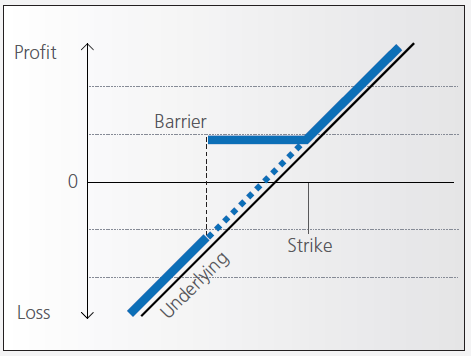
Example
Assume a bonus certificate on ABC share. The certificate has a strike of EUR 45.00 and a barrier set at EUR 36.00. The table below shows scenarios depending on the trading range of the underlying, the final price of the underlying and whether the barrier has been touched or not.
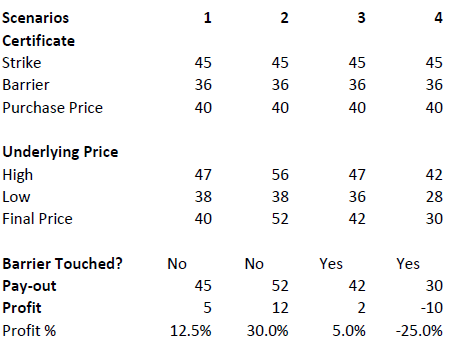
Warrant Tutorial
Introduction
A warrant confers the right to buy (call-warrant) or sell (put-warrant) a specific quantity of a specific underlying instrument at a specific price over a specific period of time.
Pay-out Profile
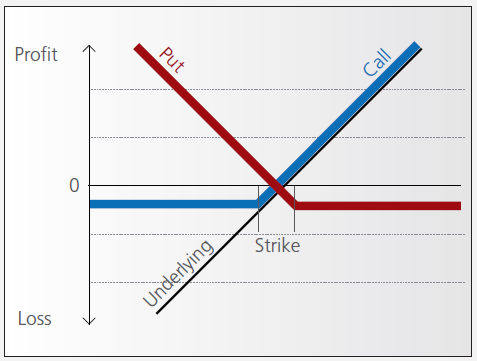
With some warrants, the option right can only be exercised on the expiration date. These are referred to as “European-style” warrants. With “American-style” warrants, the option right can be exercised at any time prior to expiration. The vast majority of listed warrants are cash-exercised, meaning that you cannot exercise the warrant to obtain the underlying physical share. The exception to this rule is Switzerland, where physically settled warrants are widely available.
Factors that influence pricing
Not only do changes in the price of the underlying instrument influence the value of a warrant, a number of other factors are also involved. Of particular importance to investors in this regard are changes in volatility, i.e. the degree to which the price of the underlying instrument fluctuates. In addition, changes in interest rates and the anticipated dividend payments on the underlying instrument also play a role.
However, changes in implied volatility - as well as interest rates and dividends - only affect the time value of a warrant. The primary driver - intrinsic value - is solely determined by the difference between the price of the underlying instrument and the specified exercise price.
Historical and implied volatility
In addressing this topic, a differentiation has to be made between historical and implied volatility. Implied volatility reflects the volatility market participants expect to see in the financial instrument in the days and months ahead. If implied volatility for the underlying instrument increases, so does the price of the warrant.
This is because the probability of profiting from a warrant during a particular time-frame increases if the price of the underlying instrument is highly volatile. The warrant is therefore more valuable.
Conversely, if implied volatility decreases, that leads to a decline in the value of warrants and hence occasionally to nasty surprises for warrant investors who aren’t familiar with the concept and influence of volatility.
Interest rates and dividends
Issuers hedge themselves against price changes in the warrant through purchases and sales of the underlying instrument. Due to the leverage afforded by warrants, the issuer needs considerably more capital to hedge its exposure than you require to buy the warrants. The issuer’s interest expense associated with that capital is included in the price of the warrant. The amount of embedded interest reduces over time and at expiration is zero.
In the case of puts, the situation is exactly the opposite. Here, the issuer sells the underlying instrument
short to establish the necessary hedge, and in so doing receives capital that can earn interest. Thus interest reduces the price of the warrant by an amount that decreases over time.
As the issuer owns shares as a part of its hedging operations, it is entitled to receive the related dividend
payments. That additional income reduces the price of call warrants and increases the price for puts. But if the dividend expectations change, that will have an influence on the price of the warrants. Unanticipated special dividends on the underlying instrument can lead to a price decline in the related warrants.
Key valuation factors
Let’s assume the following warrant:
Warrant Type: Call
Term to expiration: 2 years
Underlying : ABC Share
Share price: EUR 30.00
Strike: EUR 30.00
Exercise ratio: 0.1
Warrant’s price: EUR 0.30
Intrinsic value
Intrinsic value represents the amount you could receive if you exercised the warrant immediately and then bought (in the case of a call) or sold (put) the underlying instrument in the open market.
It’s very easy to calculate the intrinsic value of a warrant. In our example the intrinsic value is EUR 00.00
and is calculated as follows:
(price of underlying instrument – strike price) x exercise ratio
= (EUR 30.00 – EUR 30.00) x 0.1
= EUR 00.00
If the price of the ABC share increases by EUR 1, the intrinsic value becomes
= (EUR 31.00 – EUR 30.00) x 0.1
= EUR 00.10
The intrinsic value of a put warrant is calculated with this formula:
(strike price – price of underlying instrument) x exercise ratio
It’s important to note that the intrinsic value of a warrant can never be negative. By way of explanation:
if the price of the underlying instrument is at or below the exercise price, the intrinsic value of a call equals zero. In this instance, the price of the warrant consists only of “time value”. On the flipside, the intrinsic value of a put is equal to zero if the price of the underlying instrument is at or above the exercise price.
Time value
Once you’ve calculated the intrinsic value of a warrant, it’s also easy to figure out what the time value of that warrant is. You simply deduct the intrinsic value from the current market price of the warrant. In our example, the time value is equal to EUR 1.30 as you can see from the following calculation:
(warrant price – intrinsic value)
= (EUR 0.30 EUR – EUR 0.00)
= EUR 0.30
Time value gradually erodes during the term of a warrant and ultimately ends up at zero upon expiration. At that point, warrants with no intrinsic value expire worthless. Otherwise you can expect to receive payment of the intrinsic value. Take note, though: a warrant’s loss of time value accelerates during the final months of its term.
Premium
The premium indicates how much more expensive a purchase/sale of the underlying instrument would be via the purchase of a warrant and the immediate exercise of the option right as opposed to simply buying/selling the underlying instrument in the open market.
Hence the premium is a measure of how expensive a warrant actually is. It follows that, when given a choice between warrants with similar features, you should always buy the one with the lowest premium. By calculating the premium as an annualized percentage, warrants with different terms to expiry can be compared with each other.
The percentage premium for the call warrant in our example can be calculated as follows:
(strike price + warrant price / exercise ratio – share price) / share price * 100
= (EUR 30.00 + EUR 0.30 / 0.1 – EUR 30.00) / EUR 30.00 x 100
= 10 percent
Leverage
The amount of leverage is the price of the share * ratio divided by the price of the warrant. In our example 30.00*0.1/0.3 = 10. So when the price of ABC increases by 1% the value of the warrant increases by 10%.
The amount of leverage is not constant however; it varies as intrinsic and time value changes, and is particularly sensitive to changes in intrinsic value. As a rule of thumb, the higher the intrinsic value of the warrant, the lower the leverage. For example (assuming constant time value):

Knock-out (Turbo) Tutorial
Introduction
Knock-out warrants (turbos), like vanilla warrants, derive their value from the difference between the price of the underlying and the strike. They differ significantly however from vanilla warrants in many important respects:
- They can expire (knock-out) prematurely if the price of the underlying instrument touches or falls below (in the case of knock-out calls) or exceeds (in the case of knockout puts) a predetermined barrier-level. It expires worthless if the barrier equals the strike, or it may have a residual stop-loss value if the barrier is set higher than the strike (in the case of a call).
- Changes in implied volatility have little or no impact on knock-out products, therefore their pricing is easier for investors to comprehend than that of warrants.
- They have little or no time value (because of the presence of the knock-out barrier), and therefore have a higher degree of leverage than a warrant with the same strike. This is because the absence of time value makes the instrument “cheaper”.
Pay-out Profile
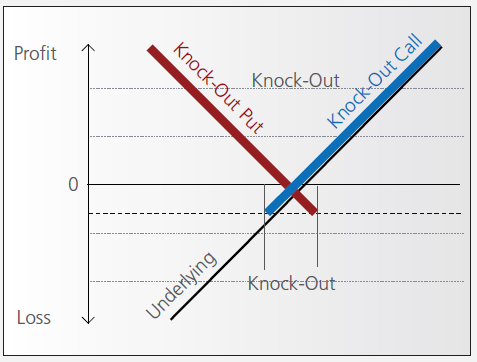
Leverage
As discussed above, knock-out warrants exhibit high degrees of leverage, particularly as the price of the underlying nears the strike/barrier. Consider the following example of a long turbo on the Dow Jones Index, compared to a vanilla warrant:
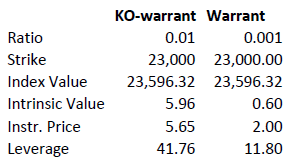
Intrinsic value = (index value – strike) x ratio
Leverage = Index Value x Ratio / Instrument Price
A vanilla warrant retains significant time value even as the underlying price approaches the strike, sharply reducing its leverage compared to a knock-out warrant.
Product types
As discussed above, the barrier may either equal the strike, or be set above (calls) or below (puts). In the latter cases a small residual value remains after knock-out, corresponding to the difference between the barrier (the stop-loss level) and the strike.
Moreover, knock-out products may either have an expiration date or may be open-ended. This makes a difference in the way interest is accounted for. If the contract has an expiration date interest is included in the premium, the amount of which reduces over time and is zero on expiration. This is analogous to a standard vanilla warrant.
in relation to an expiration date. The price of the contract therefore corresponds exactly to its intrinsic value. Interest however must be accounted for. This is done by a daily adjustment of the barrier and strike. The following example shows the daily adjustment for a long open-end turbo on the Dow Jones Index:
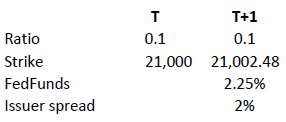
The adjustment = Strike T x (1+ FedFunds/360 + Issuer Spread/360).
The intrinsic value of the instrument is correspondingly reduced as follows, assuming no change in the value of the DJ Index):

Intrinsic value = (index value – strike) x ratio
